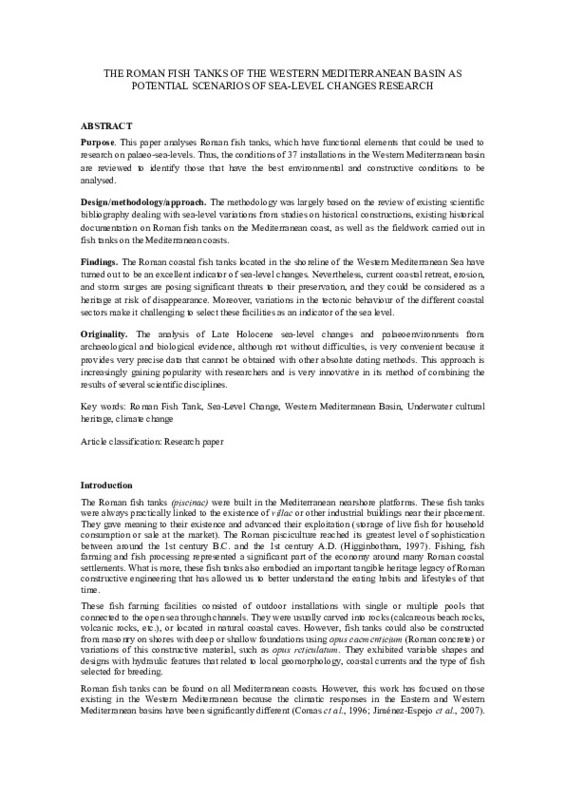JavaScript is disabled for your browser. Some features of this site may not work without it.
Buscar en RiuNet
Listar
Mi cuenta
Estadísticas
Ayuda RiuNet
Admin. UPV
The Roman fish tanks of the Western Mediterranean basin as potential scenarios for research on sea-level changes
Mostrar el registro sencillo del ítem
Ficheros en el ítem
| dc.contributor.author | Caballero-Rubio, Francisco Javier
|
es_ES |
| dc.contributor.author | Viñals Blasco, Mª José
|
es_ES |
| dc.contributor.author | Tormo-Esteve, Santiago
|
es_ES |
| dc.date.accessioned | 2024-01-02T19:02:29Z | |
| dc.date.available | 2024-01-02T19:02:29Z | |
| dc.date.issued | 2022-04-26 | es_ES |
| dc.identifier.issn | 2044-1266 | es_ES |
| dc.identifier.uri | http://hdl.handle.net/10251/201338 | |
| dc.description.abstract | [EN] Purpose ¿ This paper analyses Roman fish tanks, which have functional elements that could be used to research on palaeo-sea-levels. Thus, the conditions of 37 installations in the Western Mediterranean basin are reviewed to identify those that have the best environmental and constructive conditions to be analyzed. Design/methodology/approach ¿ The methodology was largely based on the review of existing scientific bibliography dealing with sea-level variations from studies on historical constructions, existing historical documentation on Roman fish tanks on the Mediterranean coast, as well as the fieldwork carried out in fish tanks on the Mediterranean coasts. Findings ¿ The Roman coastal fish tanks located in the shoreline of the Western Mediterranean Sea have turned out to be an excellent indicator of sea-level changes. Nevertheless, current coastal retreat, erosion and storm surges are posing significant threats to their preservation, and they could be considered as a heritage at risk of disappearance. Moreover, variations in the tectonic behaviour of the different coastal sectors make it challenging to select these facilities as an indicator of the sea level. Originality/value ¿ The analysis of Late Holocene sea-level changes and palaeoenvironments from archaeological and biological evidences, although not without difficulties, is very convenient because it provides very precise data that cannot be obtained with other absolute dating methods. This approach is increasingly gaining popularity with researchers and is very innovative in its method of combining the results of several scientific disciplines. | es_ES |
| dc.language | Inglés | es_ES |
| dc.publisher | Emerald | es_ES |
| dc.relation.ispartof | Journal of Cultural Heritage Management and Sustainable Development | es_ES |
| dc.rights | Reserva de todos los derechos | es_ES |
| dc.subject | Roman fish tank | es_ES |
| dc.subject | Sea-level change | es_ES |
| dc.subject | Western Mediterranean basin | es_ES |
| dc.subject | Underwater cultural heritage | es_ES |
| dc.subject | Climate change | es_ES |
| dc.subject.classification | GEOGRAFIA FISICA | es_ES |
| dc.subject.classification | CONSTRUCCIONES ARQUITECTONICAS | es_ES |
| dc.title | The Roman fish tanks of the Western Mediterranean basin as potential scenarios for research on sea-level changes | es_ES |
| dc.type | Artículo | es_ES |
| dc.identifier.doi | 10.1108/JCHMSD-05-2021-0096 | es_ES |
| dc.rights.accessRights | Abierto | es_ES |
| dc.contributor.affiliation | Universitat Politècnica de València. Escuela Técnica Superior de Arquitectura - Escola Tècnica Superior d'Arquitectura | es_ES |
| dc.description.bibliographicCitation | Caballero-Rubio, FJ.; Viñals Blasco, MJ.; Tormo-Esteve, S. (2022). The Roman fish tanks of the Western Mediterranean basin as potential scenarios for research on sea-level changes. Journal of Cultural Heritage Management and Sustainable Development. 12(2):92-106. https://doi.org/10.1108/JCHMSD-05-2021-0096 | es_ES |
| dc.description.accrualMethod | S | es_ES |
| dc.relation.publisherversion | https://doi.org/10.1108/JCHMSD-05-2021-0096 | es_ES |
| dc.description.upvformatpinicio | 92 | es_ES |
| dc.description.upvformatpfin | 106 | es_ES |
| dc.type.version | info:eu-repo/semantics/publishedVersion | es_ES |
| dc.description.volume | 12 | es_ES |
| dc.description.issue | 2 | es_ES |
| dc.relation.pasarela | S\455959 | es_ES |
| dc.subject.ods | 04.- Garantizar una educación de calidad inclusiva y equitativa, y promover las oportunidades de aprendizaje permanente para todos | es_ES |







![[Cerrado]](/themes/UPV/images/candado.png)

